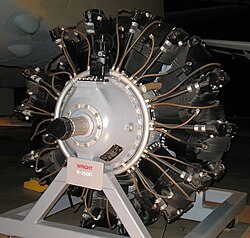Top Qs
Timeline
Chat
Perspective
Wright Cyclone series
From Wikipedia, the free encyclopedia
Remove ads
Wright Cyclone was the name given to a family of air-cooled radial piston engines designed by the Wright Aeronautical Corporation and used in numerous American aircraft in the 1930s, 1940s and 1950s.
Background
The Wright Aeronautical Corporation was formed in 1919, initially to develop liquid-cooled Hispano-Suiza V8 engines under license.[1] In 1923 the Wright purchased the Lawrance Aero Engine Company, and with the purchase Charles Lawrance came to Wright as the Vice-President.[1] Later that year the US Navy awarded Wright a contract to develop two new air-cooled radial engines. The first, called the P-1, was a 9-cylinder single row design of 1,652 cu in (27.07 L) displacement that was derived from an earlier Lawrence design, it produced 400 hp (300 kW).[2] The second, the P-2, had the same 1,652 cu in (27.07 L) displacement as the P-1, but was an improved design that produced 435 hp (324 kW).[2] Neither engine entered production, with the Navy selecting the superior Pratt & Whitney R-1340 Wasp, so in 1926 work started on the improved 1,750 cu in (28.7 L) design, which became the R-1750 Cyclone.[3]
Remove ads
Cyclone family
Summarize
Perspective
R-1300 Cyclone 7 (1942)[4][5]
- 7-cylinder single row air cooled radial
- Bore x stroke: 6+1⁄8 in × 6+5⁄16 in (156 mm × 160 mm)
- Displacement: 1,301 cu in (21.32 L)
- Power output: 800 hp (600 kW)
R-1750 Cyclone (1926)[2][6][3]
- 9-cylinder single row air cooled radial
- Bore x stroke: 6 in × 6+7⁄8 in (152 mm × 175 mm)
- Displacement: 1,750 cu in (28.7 L)
- Power output: 500–525 hp (373–391 kW)
R-1820 Cyclone (1932)[7][8][9]
- 9-cylinder single row air cooled radial
- Bore x stroke: 6+1⁄8 in × 6+7⁄8 in (156 mm × 175 mm)
- Displacement: 1,823 cu in (29.87 L)
- Power output: 575–1,525 hp (429–1,137 kW)
R-2600 Cyclone 14 (Twin Cyclone) (1935)[10][11]
- 14-cylinder two row air cooled radial
- Bore x stroke: 6+1⁄8 in × 6+5⁄16 in (156 mm × 160 mm)
- Displacement: 2,603 cu in (42.66 L)
- Power output: 1,400–1,900 hp (1,000–1,400 kW)
R-3350 Cyclone 18 (Duplex Cyclone) (1937)[10][12]
- 18-cylinder two row air cooled radial
- Bore x stroke: 6+1⁄8 in × 6+5⁄16 in (156 mm × 160 mm)
- Displacement: 3,347 cu in (54.85 L)
- Power output: 1,800–2,800 hp (1,300–2,100 kW)
- 22-cylinder two row air cooled radial
- Bore x stroke: 6+1⁄8 in × 6+5⁄16 in (156 mm × 160 mm)
- Displacement: 4,090 cu in (67.0 L)
Note: the designations refer to the engine configurations as follows: "R" = Radial, followed by the approximate displacement in cubic inches.
Remove ads
See also
- Pratt & Whitney Wasp series – contemporary competing line of engines
- Wright Whirlwind series – contemporary smaller displacement line of engines
References
Wikiwand - on
Seamless Wikipedia browsing. On steroids.
Remove ads




